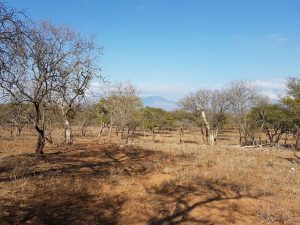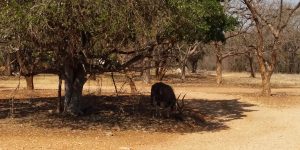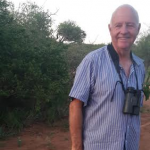Nature Natter: Drought 2
• 23 augustus 2016
The second part of the drought post by John Gear: Drought on Zandspruit
Two years ago walking in the bush in mid-winter was still a prickly and itchy experience as you brushed through knee-high grass that had lots of seed heads. Today a walk in the bush is mainly on dry red earth with only widely scattered stubby tufts of grass remaining. The earth is powdery and dry and the small plants (herbs) that offer winter feed are almost completely gone. There are many signs of unusual animal behaviour; breaking of branches to reach a few green shoots, and lots of excavating for nutritious roots and tubers.
What does all this mean for us on Zandspruit?
There are a number of lessons.
We on Zandspruit have a variety of animal species dependent on plants and water for their survival. Given that there is at least one artificial water point on Zandspruit water is NOT an immediate concern. However adequate food is a challenge. Some of our animals (particularly warthog, waterbuck, wildebeest and Zebra) are obligate or near-obligate grazers meaning they are exclusively dependent on grass and are in the most danger. Their suffering attracts sympathy and emotional outpouring manifesting in gestures of goodwill. These include wanting to feed the animals from our verandahs (of course you know this is NOT ALLOWED), and watering the bush around our homes, which might be regarded as “gardening” as long as it is a very small area. Such actions are understandable BUT they are not necessarily helpful. Animals which may have died will now survive another month or two and while alive they will compete with stronger animals for precious resources ultimately putting a larger number at risk of dying if spring rains are delayed. Furthermore feeding encourages bad behaviour of animals and accidents will occur. You may have read of the hyena attacking a young boy in Kruger Park. Officials are blaming campers for teaching the animals bad habits by throwing their bones over the fence. We have no fences so accidents are more likely. PLEASE do not feed.

Early and limited culling
Early reduction of animal numbers is good because it reduces the number using limited winter feed. Sadly, because the drought is widespread there is no market for captured antelope. So capture and sell is not a viable option. Culling becomes our only choice. Culling is an absolutely critical management tool of smaller estates that have limited carrying capacity particularly those without a meaningful predator population. Zandspruit has undertaken early and limited culling to address these challenges. The meat will be put to good use. To reassure all there is a Plan B which will entail feeding a select few allowing us to retain breeding stock for when the years of plenty return. Hopefully Plan B will not be needed.
Back to us as Zandspruit owners; our “gardens” are sources of great joy whether they be unspoilt bush or a carefully nurtured selection of our favourite indigenous plants. The drought has provided a wake-up call. The nurtured plantings are sought out by those garden “pests” – the nyala, the porcupine, the bushbuck and kudu. Inevitably plants are going to be damaged if not killed. The lack of rain has made our gardens more vulnerable and so some more delicate plantings are likely to die during this long dry season. It raises the question. How wise to try to “garden” at all?

We need to conserve water and so have to limit watering. Nyala are busy breaking branches to reach delicate soft leaves. Perhaps only enclosed gardens should be encouraged and for the rest we should take special care of what Zandspruit already has; maybe provide a little extra water for existing naturally occurring trees and give up on plantings except where a “screen” or feature tree seems particularly needed. The drought has certainly demonstrated nature’s power over human intrusion. We need to learn that lesson and love Zandspruit just the way it is!
We need to become more conscious about our water consumption, even introduce water restrictions, now before it is too late. Perhaps we should be building an additional reservoir now to enhance our storage capacity and to give us extra protection in bad times. Sadly our actions will not materially help the situation as we are a very small user but our actions can perhaps provide advocacy and a blueprint for modest use across the board including by commercial agriculture.
Is there any good news in this sad story?
Indeed there is reason for hope. Some will benefit and others will struggle but should survive:
The predator population is likely to expand rapidly with an abundance of weakened prey. Long live the leopards and the wild dog and their fellow predators, jackal, caracal and hyena that are part of our Zandspruit predator community.
There are also birds that exploit nature’s offerings in the drought. Vultures and fish eagles, storks and herons all profit from dying game and drying water holes.
Then there are those herbivores that are flexible in their dietary needs. They will still be stressed by food shortage but not in immediate danger. Even in winter there is “lots of food” for the less fussy; seeds and dried out fruits, fallen leaves and underground roots and tubers. Kudu, nyala, impala, and porcupines show this resilience while warthog have some flexibility.

Waterbuck and zebra are at risk but will browse in emergencies. The wildebeest is our most vulnerable herbivore and we shall be monitoring their well-being closely.
As humans sharing Zandspruit with the game will be privileged to witness this natural drama and to marvel at the adaptations and resilience of the animal population. The leafless bush makes game viewing rewarding and for easy bush walks which allow us to study tracks, bird watch and appreciate the magnificence of a dry hot winter in the African bush. We are indeed privileged to have our own small piece of Africa.
Post written by John Gear
John Gear is one of the home owners of Zandspruit Bush & Aero Estate. He is a nature enthusiast and we are very excited that he contributes to our blog with his views and ideas. John welcomes corrections, challenges and contributions from each of you, so please do leave a comment below.
Tags: drought, gardening, nature, nature natter, zandspruit water


Geef een reactie